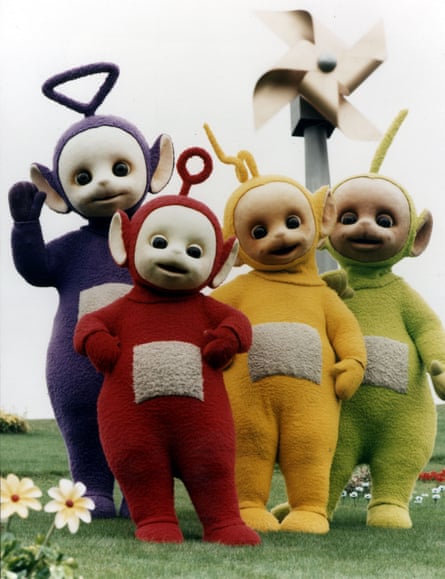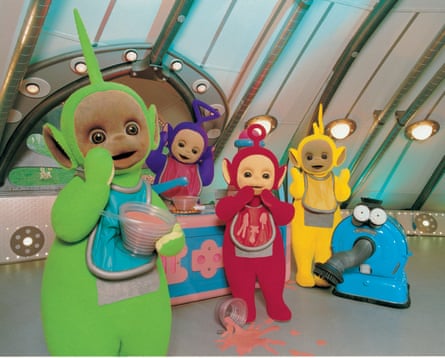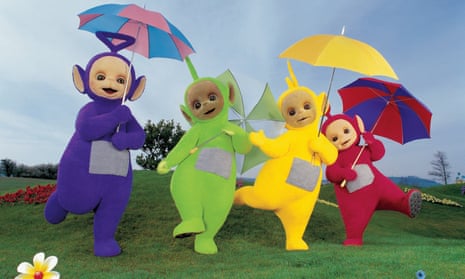Today is a momentous day. Today, the Teletubbies turn 20. They’re looking well for it, too. Unlike the vast majority of 20-year-olds, the Teletubbies own their own home, have a live-in cleaner and spend their days drifting along on the winds of serendipity, unencumbered by debt or anxiety or the nagging sense of inferiority that defines their generation. They’re the Rich Kids of Instagram, essentially, only they’ve inexplicably chosen to wear even fewer clothes.
It’s hard to imagine a time before Teletubbies. Their arrival on BBC2 at 10am on 31 March 1997 changed kids’ TV forever. Before then, any characters – especially full-body characters, such as Bungle from Rainbow or Greenclaws – tended to be accompanied by human beings for security. Most shows were just about adults dryly explaining things to an unseen audience, in English. One show was just about a rolled up piece of paper that a bloke stuck on the end of his finger. Fingermouse, it was called. It was rubbish.

Teletubbies was different. It was brightly coloured. It was airy. It was shot outside, so it had the slightest drab tinge to it. The characters communicated in what sounded like a stream of unbroken nonsense. If you were me, a 16-year-old student bunking off college in 1997, you would quickly convince yourself that you were watching a deliberately esoteric Japanese import, like Kure Kure Takora or Gamera.
Soon the press caught on to this weird new show, and there were scandals about handbags, and helicopters buzzing Home Dome, and untold treasures offered to anyone who managed to snap the Teletubby actors without their heads on. Undaunted, the show went on to spawn a million-selling hit single and hundreds of millions of pounds in merchandise sales. It became the first western kids’ show to be broadcast in China. The Simpsons parodied them. They were everywhere, a true phenomenon. And it was just a show about four big toddlers blinking into a camera. Its success was impossible to comprehend.
It’s even more difficult to comprehend now. Now, whether you like it or not, all children’s shows have a little Teletubbies DNA in them. They’re more rooted in developmental education, and less afraid to directly address their audiences in a language they’ll understand. They’re bright and fun and, in the case of In the Night Garden, even more queasily off-kilter. The shock of the new has long been dimmed, thanks to everyone’s willingness to copy the Teletubbies a little bit. To this day, this is perhaps the show’s greatest badge of success.
Plus, if Teletubbies came along today, people just wouldn’t notice. All the BBC’s pre-school programming is squirrelled away on its own channel deep down on your EPG now and, unless you have kids, you’re much less likely to accidentally stumble across it than when it was part of BBC2. They were completely a product of their time, utterly impossible to replicate any more.

If you care to watch them, new episodes of Teletubbies are still being made. The Teletubbies have different actors inside them now – Dipsy is played by Bistan the space monkey from Rogue One, for instance – and it’s very elaborately green-screened in a studio in Twickenham. The Noo-Noo is a different colour, and the episodes are half as long, but the old Teletubby magic is undeniably still there.
This is wonderful to see. The world has moved on immeasurably since 1997. Technology has quickened. Television has fragmented. But the Teletubbies are still there, exactly where they should be, laughing and hugging and blinking into camera. When the original series first aired, my efforts to secure a work experience placement on the Teletubbies set were thwarted by a foot-and-mouth outbreak. Now I watch it with my son. The first thing he ever smiled at, other than either of his parents, was a Teletubbies episode. For that alone, the show will always mean an awful lot. Here’s to the next 20 years.

Comments (…)
Sign in or create your Guardian account to join the discussion